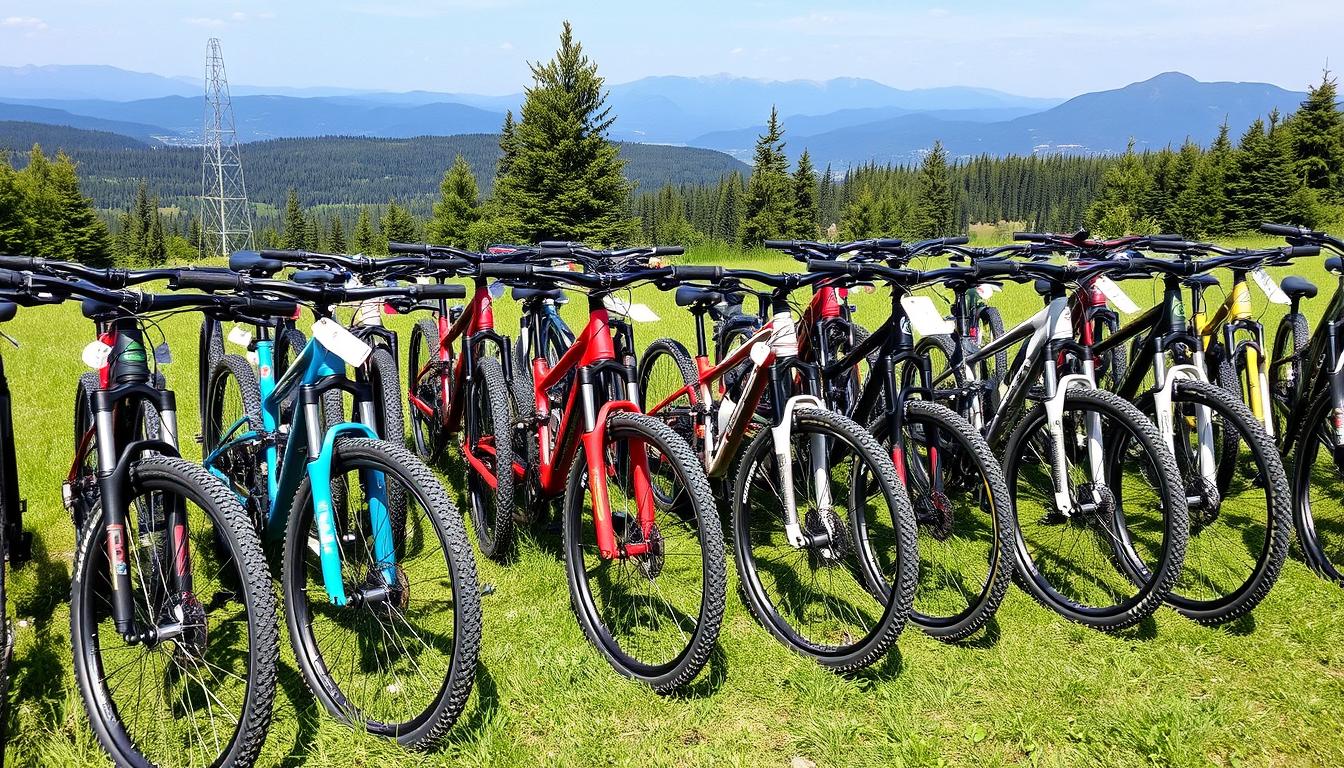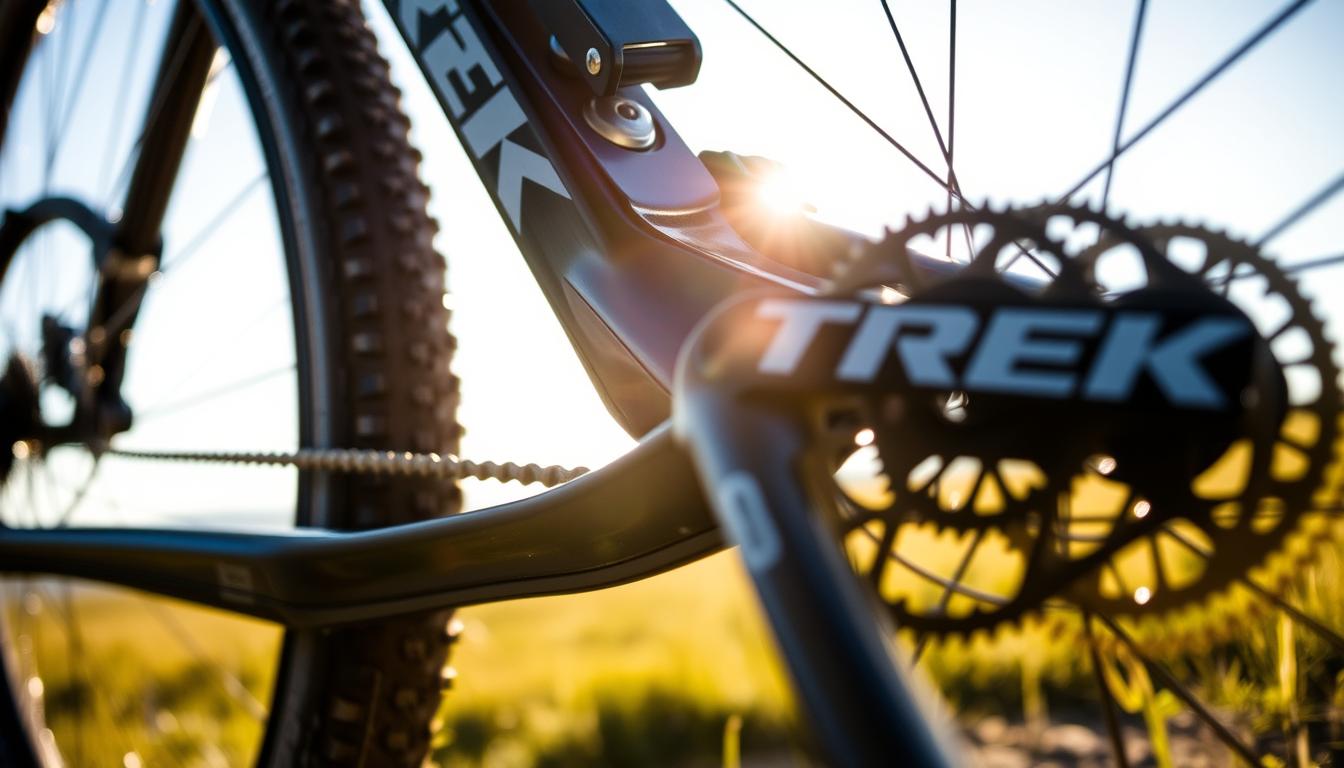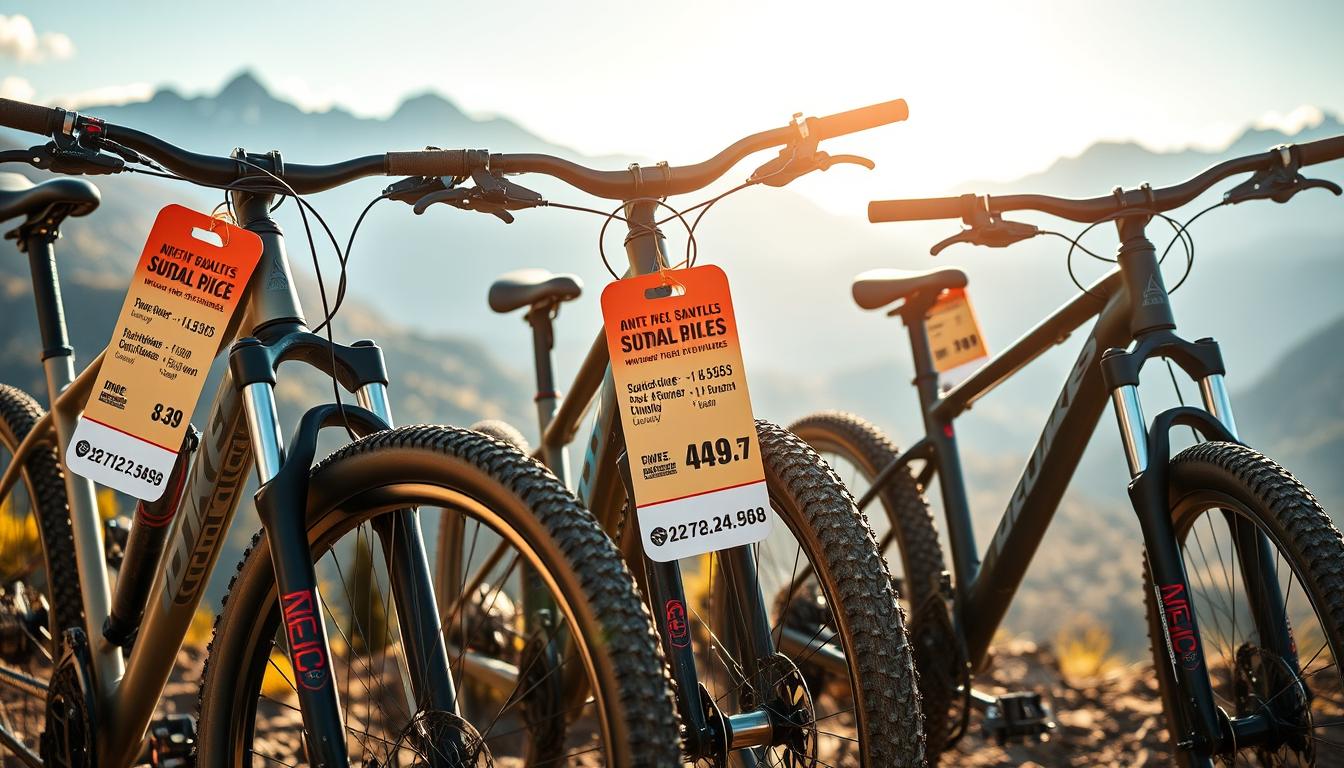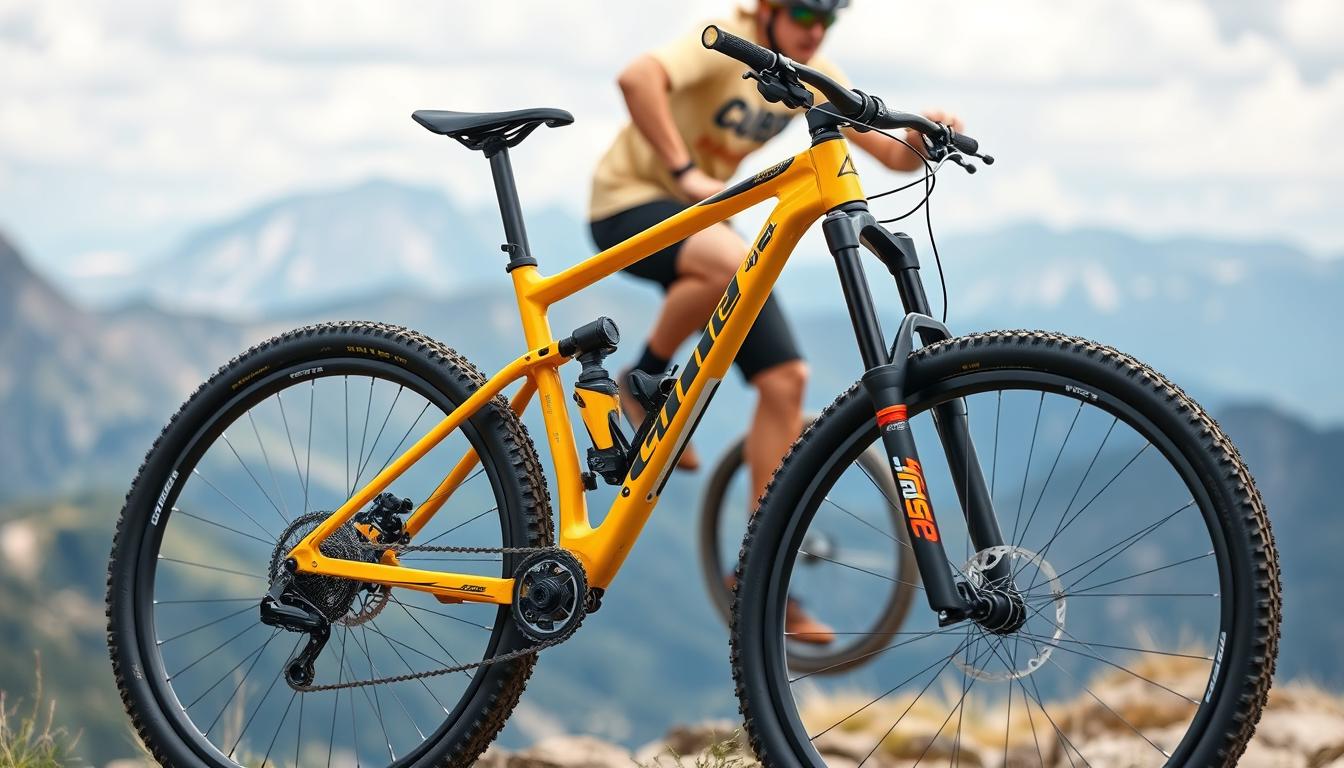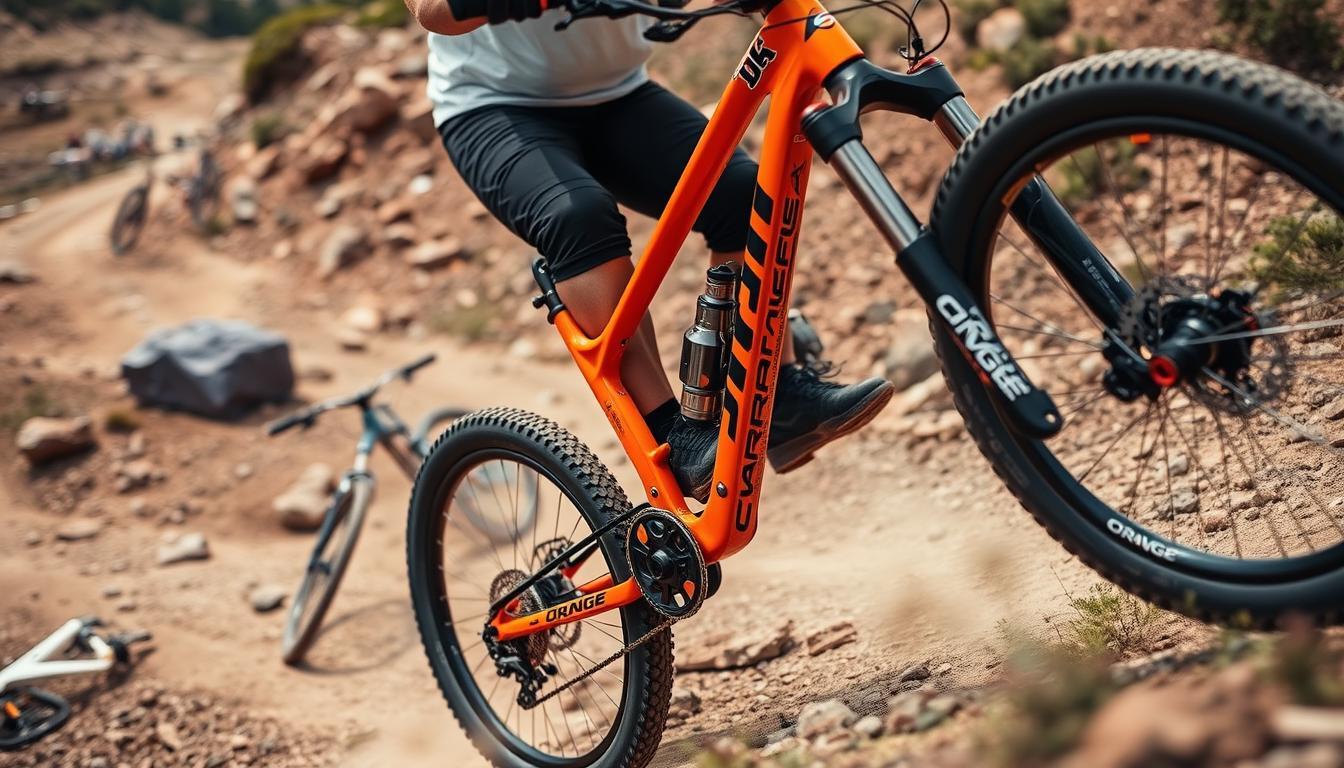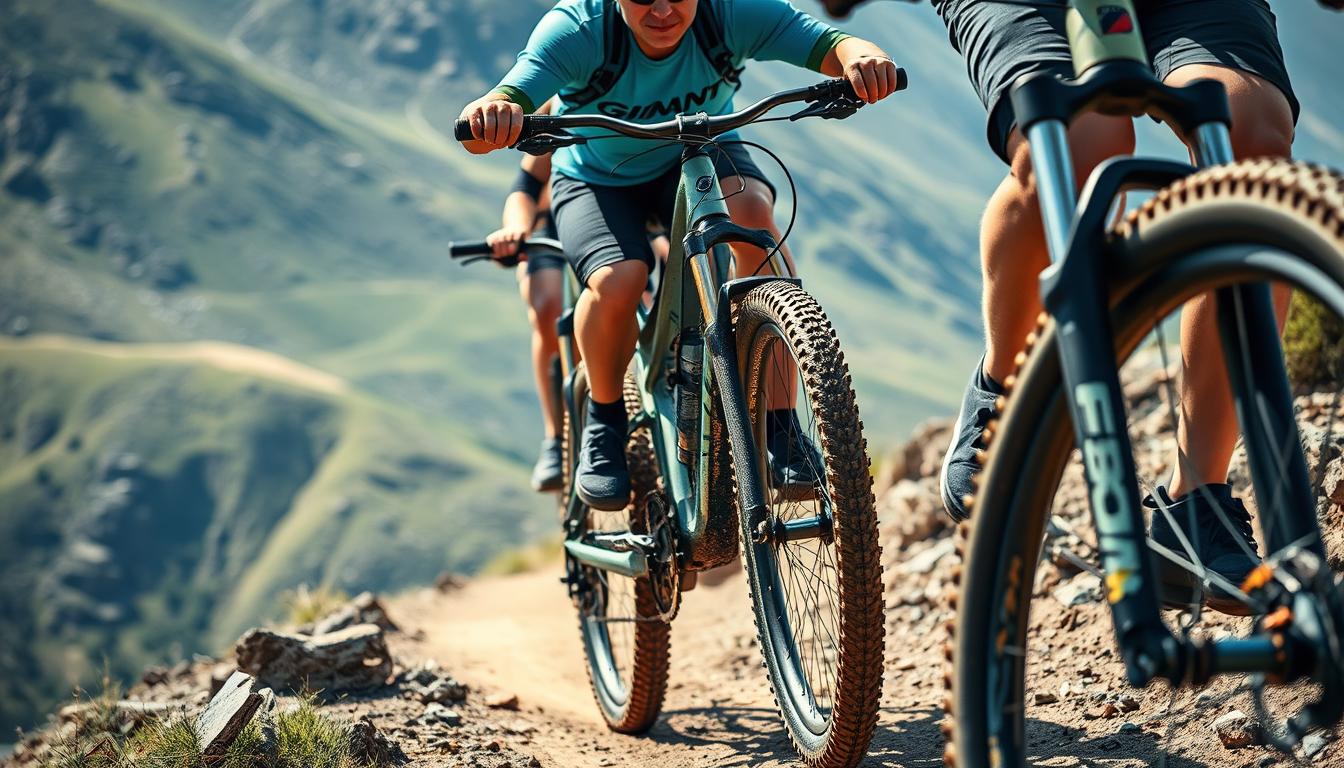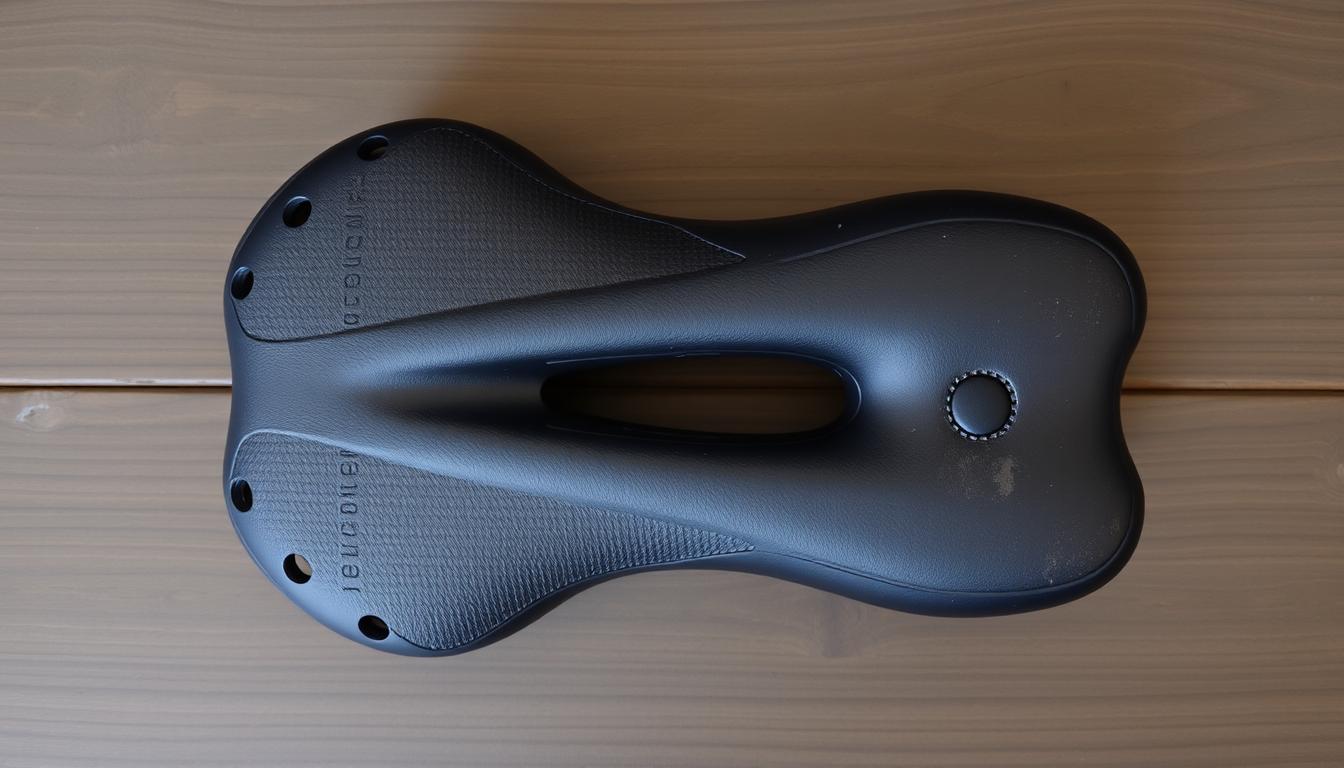Looking for affordable mountain bikes with good quality can seem hard. But, with the right tips, finding a budget-friendly bike is achievable. Top-notch mountain bikes come with carbon or aluminium frames. Yet, cheaper ones might have steel frames, making them heavier and less agile.
Knowing what matters in a mountain bike is key, like the frame material and suspension. Most find that with less than $2,000, you can get a solid bike. There are also high-quality used bikes out there. They can be a steal, offering big savings without losing out on quality.
Shops often sell refurbished bikes, and there’s a growing online market too. This makes finding a good deal easier than ever. You don’t have to give up quality even if you’re on a budget.
Understanding the Importance of Quality Components
Quality components are key for the best mountain biking. They include frame materials and suspension systems. These parts significantly improve bike performance. Learning about them helps riders choose better and enjoy more.
The Role of Frame Material
The type of material in a mountain bike frame changes its weight and how it performs. Top-end bikes use carbon fibre and high-grade aluminium for lightness and strength. In contrast, cheaper steel bikes can be heavier and not as fun to ride.
Choosing high-quality frame materials makes rides more efficient and comfortable. Riders should think carefully about their bike’s frame. It should suit their style and needs.
Impact of Suspension on Performance
The suspension system helps a mountain bike handle bumps and rough terrain. Bikes with full-suspension are best for serious biking. They offer more control and comfort. Some cheaper bikes have only front suspension or low-quality back suspension, which isn’t as effective.
There are many suspension types, and the bike’s cost often reflects its quality. For improved traction and control, the choice of suspension is crucial. Riders should consider this for a better biking experience.
Identifying the Characteristics of Good Mountain Bikes
When looking for the right mountain bike, knowing what makes a good mountain bike is key. It depends on what you like and where you’ll ride. But some things are always important. The right features can make your ride better, safer, and more comfortable.
Key Features to Consider
Finding the perfect mountain bike means looking closely at key specs. These include:
- Sturdy frame: A strong frame, made from materials like aluminum alloy or carbon fibre, is vital. It helps with durability and managing tough trails.
- Suspension type: Your riding style dictates the suspension you need. Trail bikes have 120mm to 150mm of travel. Downhill bikes have even more.
- Responsive brakes: Disc brakes are preferred for safety. They offer powerful stopping in various conditions.
- Wheel size: Larger wheels, such as 29 inches, are now more popular. They improve efficiency and speed, making climbs and descents easier.
These points indicate the bike’s performance and overall ride quality. A bike equipped with these will please both beginners and experts.
How Price Reflects Quality
The price-quality relationship in mountain bikes is crucial. High-end brands like Specialized or Trek use better materials and technology. This means more durability and better performance. However, cheaper bikes under $1000 might lack essential features for serious biking. This affects how long they last, how often they need fixing, and how well they ride.
When choosing, think about what you need and how much you can spend. Picking the right features makes your trail adventures much better. For tips on speed management and safety, check out this downhill biking guide.
Cheap Mountain Bikes: Are They Worth It?
When looking at cheap versus pricey mountain bikes, it’s important to know about performance. Budget bikes are great for relaxed riders. Yet, if you’re keen on tough trails, these bikes might not be up to scratch. They can lack the strength and safety needed for serious off-road riding. So, if intense biking is your thing, think twice about going cheap.
Cost vs Performance Analysis
Choosing a mountain bike involves deciding what quality you’re willing to pay for. Less expensive bikes often have parts that don’t last as long. This can change how well the bike rides. An entry-level bike might look good to new riders because of its lower price. But, think about what features it has. Many budget bikes don’t have great suspension or parts.
Understanding What You Might Be Sacrificing
Spending more usually means you’re getting better materials and tech. Let’s compare bikes under $1,000 to those costing between $1,500 and $3,000. The cheaper bikes often come with simpler suspension and lower quality parts. On the other hand, pricier bikes tend to have better gear systems and brakes. This makes for a smoother ride. So, low-priced bikes might seem tempting, but remember the drawbacks.
Shopping Smart: Where to Find Affordable Mountain Bikes
Looking for good yet affordable mountain bikes means you need a plan. You can check out local bike shops, dig into online shops, or eye used ones. This guide will show you how to make smart choices when hunting for budget mountain bikes.
Utilising Local Bike Shops
Local bike shops are great for finding bikes that won’t break the bank. They showcase affordable mountain bikes and give advice that fits you right. These shops also offer new and demo bikes at lower prices.
Buying locally helps small businesses in your area. It also means you might get future deals and personalised help.
Exploring Online Retailers
Shopping online for bikes presents many chances to find good deals. Trusted websites offer great customer feedback and return options to ensure you’re happy. Brands like Trek, Giant, and Diamondback often have sales on their bikes.
Always check prices, specs, and deals across sites to find the best value.
The Benefits of Used Bike Marketplaces
Places like Craigslist and Facebook Marketplace are gems for finding used mountain bikes. You can find quality bikes much cheaper. Just be sure to check the bike well before buying it.
Choosing the right used bike helps your wallet and still gives you a top ride.
Tips for Buying Second-Hand Mountain Bikes
Getting a suitable used mountain bike can greatly improve how much you enjoy your rides. There are many options out there, so it’s important to do your homework and be careful. Knowing how to check the bikes properly and what to look for can help you make a wise choice.
What to Look for in a Used Bike
Start your quest by focusing on a few important details:
- Frame integrity: Look for cracks or dents, particularly with carbon bikes, as these could be safety hazards.
- Component condition: Check the drivetrain, brakes, and wheels for wear. This could save you from pricey fixes later.
- Modifications: Examine any extra upgrades. While they can boost performance, they might also hint at previous neglect.
- Fit: Making sure the bike’s size is right for you is key for comfortable long rides.
Inspection Techniques for Durability
Using solid inspection techniques is crucial when checking out a used mountain bike:
- Test ride: Ride the bike to see how it handles and feels. Be alert for any odd sounds or performance issues.
- Check vital parts: Inspect important parts like the suspension and brakes for wear.
- Inspect wheels: Check for damage like rim dents or issues with the hub bearings that could affect the ride.
- Determine servicing history: Ask about any service done on the shocks and brakes. These are critical for the bike’s longevity but are often overlooked.
Top Brands Offering Budget-Friendly Options
Searching for quality mountain bikes on a budget means looking at trusted brands. They often have reliable, affordable options. Diamondback, Giant, and Trek are known for their budget-friendly mountain bikes. They balance performance with quality.
Popular Budget Mountain Bike Brands
Diamondback and Schwinn are leading choices for budget mountain bikes. For example, Diamondback Line 27.5 sells for around $799. Meanwhile, Schwinn’s Bonafide 29-Inch goes for $456 on Amazon. Even less known brands offer bikes that stand up well against these big names, in features and performance.
Comparing Quality Across Different Brands
When comparing budget mountain bikes, look at frame material, suspension, and build quality. Take the Hiland 26 27.5-Inch Mountain Bike; it’s only $264. It shows the kind of value available to newcomers in mountain biking. For more comparisons and recommendations, visit this resource. There are plenty of options under $1,500, making it easy for buyers to find great bikes without spending too much.
Maximising Value: How to Maintain Your Cheap Mountain Bike
Keeping your mountain bike in good shape is key to making it last longer. By taking care of it regularly, you save money and ensure it performs well. Here are some tips to help maintain your bike without spending too much.
Routine Maintenance Tips
Routine checks can greatly extend your bike’s life. Make sure to:
- Inspect and clean the brakes regularly to ensure safe stopping power.
- Check the gears and cables for smooth shifting.
- Maintain the tyres by keeping them properly inflated and checking for any wear or punctures.
- Keep the drivetrain clean by regularly lubricating the chain, which helps prevent severe wear on components.
- Consider regular suspension servicing to avoid expensive repairs down the line.
Upgrading Components on a Budget
Improving your bike’s parts can enhance its performance without buying a new one. Focus on key areas like:
- Focusing on suspension upgrades to enhance ride quality.
- Replacing the saddle for better comfort during long rides.
- Swapping out pedals for improved grip and efficiency.
Plan your budget for these improvements carefully. Consider brands like Diamondback, Giant, and Trek for good quality yet affordable components. This way, you can upgrade your bike step by step.
Conclusion
It’s totally possible to find affordable mountain bikes without losing out on quality. You just need to know where to look. Look for entry-level bikes that have good features like hydraulic brakes and solid drivetrains. This way, you’ll get great value without spending too much. Bikes costing between £350 and £550 offer great options for those careful about spending without sacrificing quality.
Throughout this article, we’ve shared tips and insights on cycling. It’s important to think about the bike’s *frame material*, *suspension*, and *components* before deciding. Even though the top-quality carbon bikes seem better, many alloy bikes also offer great performance but are much cheaper. We’ve gone deep into comparing them in our market review. You’ll find more details in this comparison of carbon vs. aluminium mountain.
Whether buying from a local shop or looking for second-hand deals, you can have an awesome biking experience without spending a lot. Making smart choices, like planning for future upgrades and picking the best value bikes, will make your cycling adventures fun and affordable.
FAQ
What should I look for in the frame material of a cheap mountain bike?
When hunting for an affordable mountain bike, think about getting one with an aluminium or carbon fibre frame. They are not only lighter but also stronger than steel. This choice will really make a difference in how your bike rides and lasts.
How does suspension affect the performance of a mountain bike?
The suspension system helps to smooth out bumps from rough paths. If you’re into tough mountain biking, go for full suspension. Yet, more affordable bikes might only have front suspension. This could mean less comfort and control on uneven grounds.
What features are essential for a good mountain bike?
Important things to look for are a reliable frame, good suspension for absorbing shocks, responsive brakes (disc brakes are a plus), and the right wheel sizes. These contribute to easier trail riding.
Is there a direct correlation between the price and quality of mountain bikes?
Yes, more expensive bikes often use better materials and parts. Brands like Specialized and Trek are known for high-quality craftsmanship. However, cheaper bikes might not be as sturdy or high-performing.
Are cheaper mountain bikes worth buying for serious riders?
For casual use or riding around the neighbourhood, cheaper bikes do the job. But serious bikers might find them lacking on tough terrains. They might not be as durable or safe for more difficult rides.
What risks come with buying used mountain bikes?
Buying a used bike can save money but beware of possible hidden issues. Always check the frame’s condition, other parts, and get it inspected thoroughly. This ensures you’re getting a good deal.
How can local bike shops aid in purchasing a budget mountain bike?
Local shops offer professional advice, deals on new or demo bikes, and services for used ones. Supporting them benefits the community and might help you find great bargains.
What are the best brands for budget-friendly mountain bikes?
Brands like Diamondback, Giant, and Trek have good, budget-friendly bikes. Looking into lesser-known brands could also reveal quality bikes at lower prices. Always do your research.
What are some quick tips for maintaining a cheap mountain bike?
Keeping your bike in shape extends its life. Pay attention to brakes, gears, and tyres. Cleaning and oiling the chain regularly boosts performance and reduces wear.
How can I upgrade my mountain bike without spending a fortune?
Upgrade bit by bit, focusing on parts that really need it. Setting aside a budget for these upgrades can improve your bike gradually. That way, you don’t need to buy a new one all at once.
